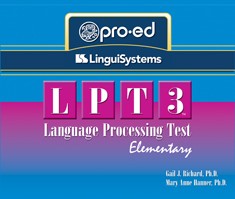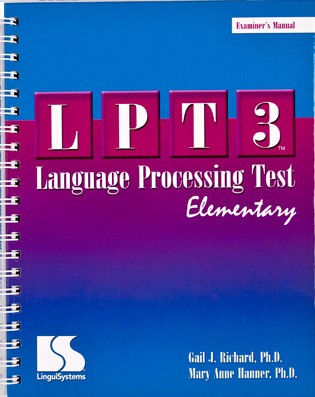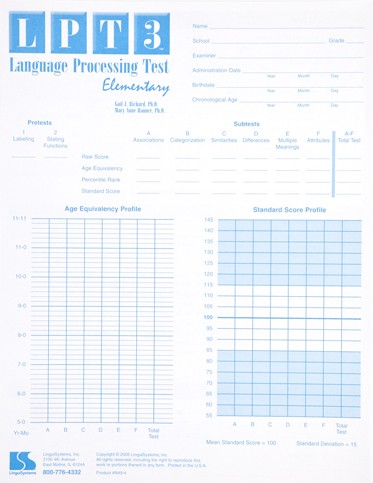Language Processing Test 3: Elementary (LPT-3:E)
COMPLETE KIT
- Ages 5 - 11
- Testing Time 35 minutes
- Administration Individual
-
Product Code 34050 ( MR #065379 )
* Qualifications required to purchase this item. Click here to complete the qualifications form.
Price $200.00
Contents
Use the Language Processing Test 3 Elementary (LPT 3) to diagnose language processing disorders in underachieving children. The test evaluates the ability to attach increasingly more meaning to information received to then formulate an expressive response.
The skills evaluated are discrete and carefully controlled, beginning with simple tasks and progressively increasing the language processing demand placed upon the student. This hierarchical approach ensures evaluation of prerequisite skills for increased processing demand. There are two pretests and six subtests. Each subsequent subtest builds on the skills previously evaluated. The test items are valid clinical indicators of the ability to attach meaning to language.
Subtests
• Pretest 1: Labeling - Name pictures with a one-word response.
• Pretest 2: Stating Functions - State a verb that describes the function of a specific noun.
• Subtest A: Associations - Name an additional item that is typically associated with a specific noun.
• Subtest B: Categorization - Name at least three items that belong to the specific category presented.
• Subtest C: Similarities - Compare two items and state the similar characteristics that place them in the same category.
• Subtest D: Differences - Contrast two items and state the differences between them.
• Subtest E: Multiple Meanings - State three definitions for each stimulus word. Each stimulus word is presented in three different sentence contexts. To receive full credit, the student must provide an acceptable definition for two of the three sentences.
• Subtest F: Attributes - Spontaneously describe a specific noun. Success on this task is evaluated by the number of different attribute areas, or depth of processing, that the student addresses without the use of prompts.

 Proud to be Canadian
Proud to be Canadian

